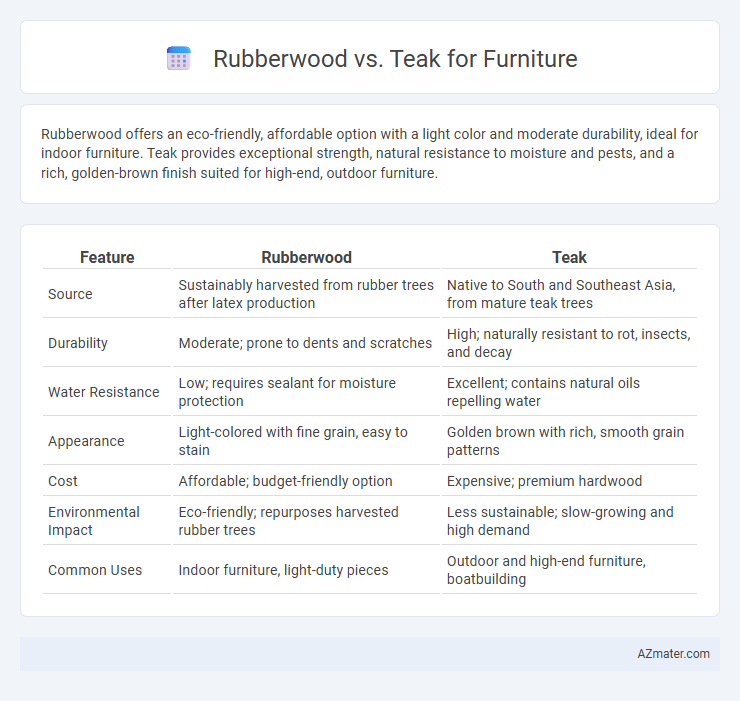Rubberwood offers an eco-friendly, affordable option with a light color and moderate durability, ideal for indoor furniture. Teak provides exceptional strength, natural resistance to moisture and pests, and a rich, golden-brown finish suited for high-end, outdoor furniture.
Table of Comparison
| Feature | Rubberwood | Teak |
|---|---|---|
| Source | Sustainably harvested from rubber trees after latex production | Native to South and Southeast Asia, from mature teak trees |
| Durability | Moderate; prone to dents and scratches | High; naturally resistant to rot, insects, and decay |
| Water Resistance | Low; requires sealant for moisture protection | Excellent; contains natural oils repelling water |
| Appearance | Light-colored with fine grain, easy to stain | Golden brown with rich, smooth grain patterns |
| Cost | Affordable; budget-friendly option | Expensive; premium hardwood |
| Environmental Impact | Eco-friendly; repurposes harvested rubber trees | Less sustainable; slow-growing and high demand |
| Common Uses | Indoor furniture, light-duty pieces | Outdoor and high-end furniture, boatbuilding |
Introduction: Rubberwood vs Teak Furniture
Rubberwood and teak are two popular materials for furniture, each offering unique qualities. Rubberwood is a sustainable option harvested from rubber trees after latex production ends, known for its affordability and light grain. Teak stands out for its durability, rich natural oils, and resistance to weather, making it ideal for high-end indoor and outdoor furniture.
Botanical Origins and Growth Environments
Rubberwood, derived from the Hevea brasiliensis tree native to Southeast Asia, grows predominantly in plantation environments with humid tropical climates optimized for quick maturation within 25-30 years. Teak, scientifically known as Tectona grandis, thrives in mixed hardwood forests across South and Southeast Asia, requiring 50-70 years to reach harvest maturity due to its slow growth in drier and more variable monsoon conditions. The distinct botanical origins and environmental adaptations of rubberwood and teak influence their grain patterns, density, and suitability for various furniture applications.
Wood Appearance and Grain Patterns
Rubberwood features a light, pale color with subtle, straight grain patterns that create a clean and uniform appearance, making it ideal for modern and minimalist furniture designs. Teak wood boasts a rich golden-brown hue with striking, wavy grain patterns and natural oils that provide a glossy finish and enhance durability. The pronounced grains and warm tones of teak offer a luxurious, timeless look, whereas rubberwood's smoother texture supports versatile staining options to mimic other wood types.
Durability and Longevity Comparison
Rubberwood offers moderate durability with resistance to wear and insects but is less dense and prone to dents compared to teak. Teak boasts exceptional longevity due to its natural oils, high density, and resistance to moisture, decay, and pests, making it ideal for both indoor and outdoor furniture. While rubberwood is more affordable and eco-friendly as a byproduct of latex production, teak's superior durability justifies its higher cost for long-lasting, premium furniture.
Resistance to Moisture, Pests, and Decay
Rubberwood offers moderate resistance to moisture but requires treatment to prevent swelling and warping, while teak is highly resistant to moisture due to its natural oils, making it ideal for humid environments. Teak's natural oils also provide superior protection against pests and fungal decay, unlike rubberwood, which is more susceptible without chemical treatments. For outdoor or high-moisture furniture, teak outperforms rubberwood in durability and longevity against environmental factors.
Sustainability and Environmental Impact
Rubberwood furniture is highly sustainable as it utilizes plantation timber from rubber trees that have completed their latex-producing cycle, reducing deforestation and waste. Teak, while prized for its durability and resistance to pests, often comes from slower-growing hardwood forests, leading to concerns over illegal logging and habitat loss. Choosing certified sustainably sourced rubberwood offers a lower environmental impact and supports circular economy practices compared to traditional teak harvesting.
Workability and Ease of Crafting
Rubberwood offers exceptional workability due to its uniform texture and moderate hardness, making it ideal for intricate carving and smooth finishing in furniture crafting. Teak, while highly durable and resistant to decay, poses challenges in machining because of its natural oils, requiring specialized tools and treatments to achieve fine detailing. Both woods are favored for different furniture applications, with Rubberwood excelling in ease of crafting and Teak prized for longevity despite its tougher workability.
Cost and Market Availability
Rubberwood furniture is significantly more affordable than teak, making it a cost-effective option for budget-conscious buyers. Teak, known for its durability and rich oils, commands higher prices due to slow growth and limited supply, positioning it as a premium market choice. Rubberwood's wide availability, especially in Southeast Asia, contrasts with teak's more restricted market, influencing purchasing decisions based on budget and accessibility.
Maintenance and Care Requirements
Rubberwood requires regular cleaning with a damp cloth and occasional application of furniture oil to maintain its finish and prevent drying or cracking, making it relatively low-maintenance. Teak, known for its natural oils and high density, demands less frequent upkeep but benefits from periodic oiling to preserve its rich color and protect against weathering, especially when used outdoors. Both woods resist pests, but teak's superior durability and resistance to moisture make it ideal for long-lasting furniture with minimal maintenance efforts.
Final Verdict: Choosing Between Rubberwood and Teak
Rubberwood offers an affordable, eco-friendly option with moderate durability and a light, smooth finish ideal for budget-conscious furniture buyers. Teak is a premium hardwood known for its exceptional strength, natural resistance to moisture and pests, and rich golden color, making it a long-lasting investment for high-end furniture. Choosing between rubberwood and teak depends on balancing cost, durability needs, and aesthetic preferences, with teak favored for outdoor or heirloom pieces and rubberwood suitable for casual, indoor furniture.

Infographic: Rubberwood vs Teak for Furniture
 azmater.com
azmater.com